Organizational Culture Report: Hofstede Dimensions and Suggestions
VerifiedAdded on 2021/01/01
|6
|1328
|436
Report
AI Summary
This report provides an in-depth analysis of organizational culture, focusing on Hofstede's cultural dimensions. It begins with an introduction defining organizational culture and its significance, followed by an evaluation of individualism vs. collectivism, power distance, uncertainty avoidance, and masculinity vs. femininity. The report then presents the author's agreement and disagreement with certain dimensions, providing justifications for their perspective. Furthermore, it offers suggestions for companies, advocating for a collectivism approach to foster teamwork and enhance organizational growth. The conclusion summarizes the key findings, emphasizing the importance of understanding diverse organizational cultures and the benefits of adopting a balanced approach to cultural dimensions. References include books, journals, and online resources supporting the analysis.
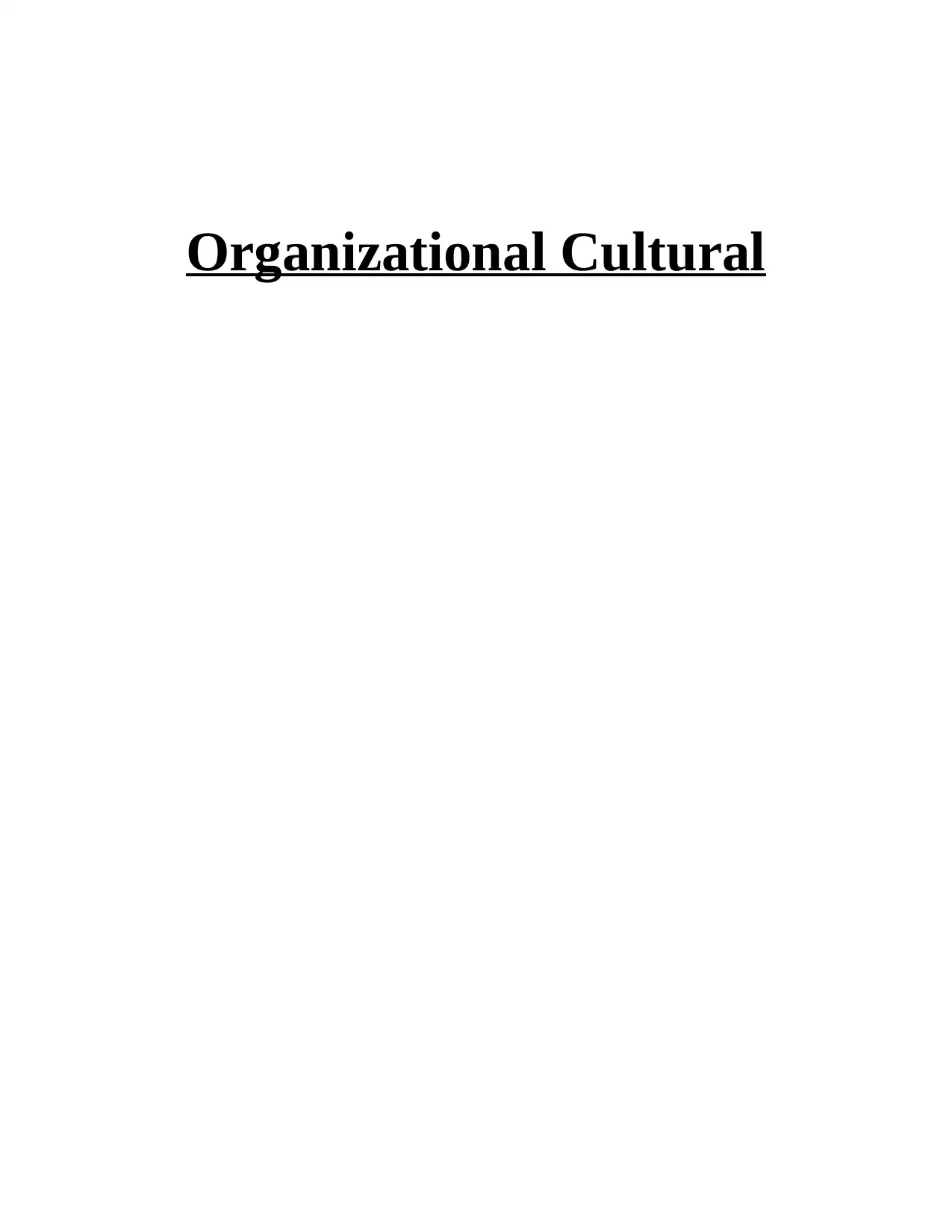
Organizational Cultural
Paraphrase This Document
Need a fresh take? Get an instant paraphrase of this document with our AI Paraphraser
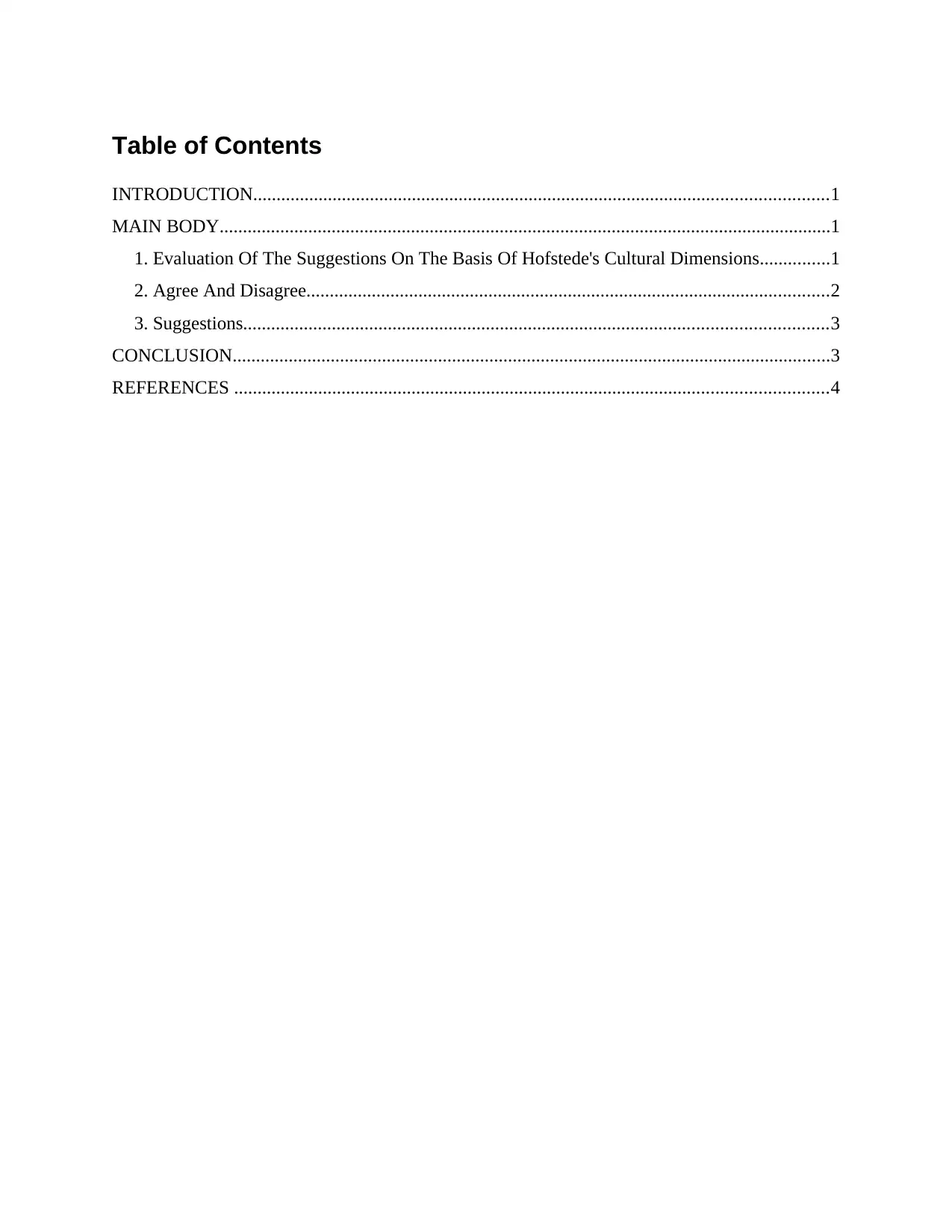
Table of Contents
INTRODUCTION...........................................................................................................................1
MAIN BODY...................................................................................................................................1
1. Evaluation Of The Suggestions On The Basis Of Hofstede's Cultural Dimensions...............1
2. Agree And Disagree................................................................................................................2
3. Suggestions.............................................................................................................................3
CONCLUSION................................................................................................................................3
REFERENCES ...............................................................................................................................4
INTRODUCTION...........................................................................................................................1
MAIN BODY...................................................................................................................................1
1. Evaluation Of The Suggestions On The Basis Of Hofstede's Cultural Dimensions...............1
2. Agree And Disagree................................................................................................................2
3. Suggestions.............................................................................................................................3
CONCLUSION................................................................................................................................3
REFERENCES ...............................................................................................................................4
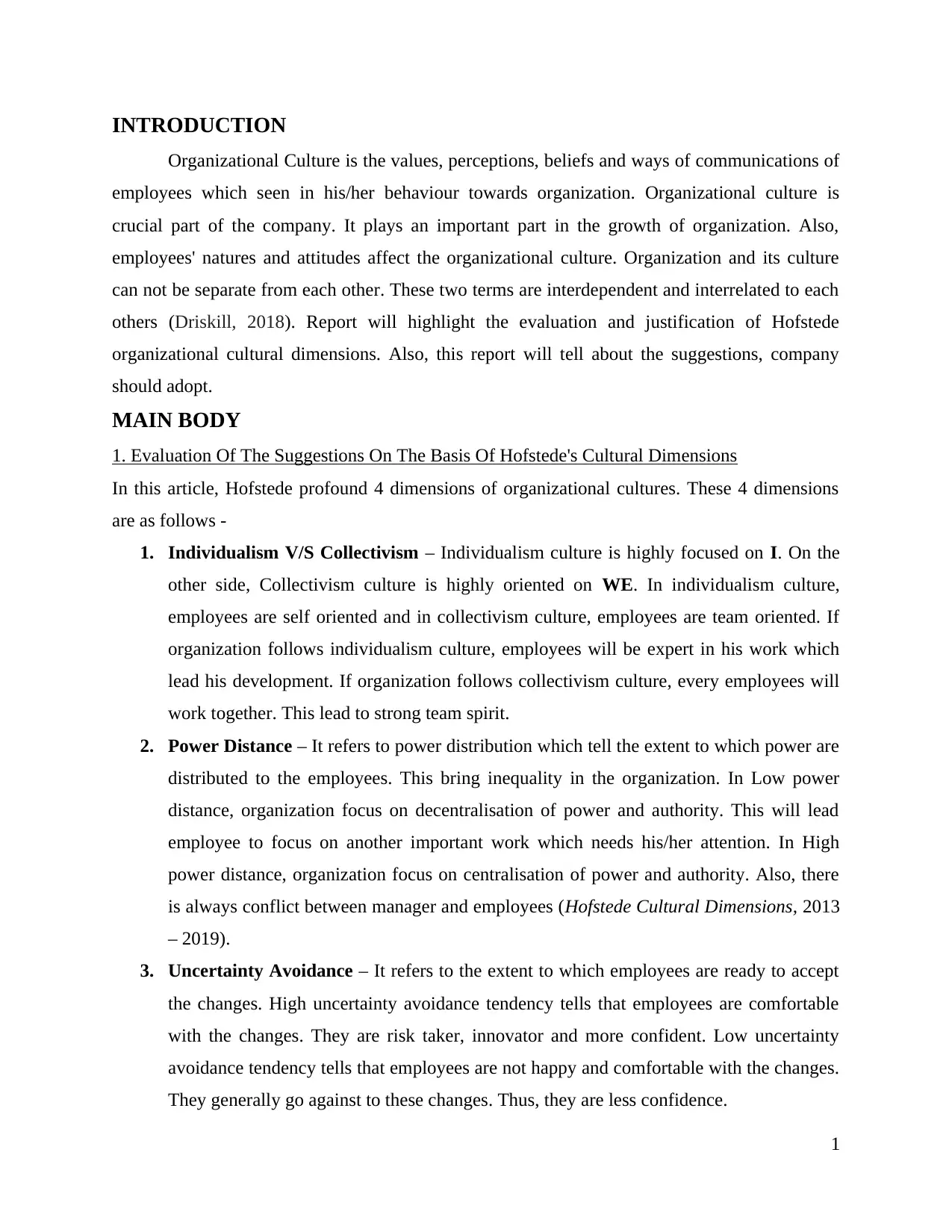
INTRODUCTION
Organizational Culture is the values, perceptions, beliefs and ways of communications of
employees which seen in his/her behaviour towards organization. Organizational culture is
crucial part of the company. It plays an important part in the growth of organization. Also,
employees' natures and attitudes affect the organizational culture. Organization and its culture
can not be separate from each other. These two terms are interdependent and interrelated to each
others (Driskill, 2018). Report will highlight the evaluation and justification of Hofstede
organizational cultural dimensions. Also, this report will tell about the suggestions, company
should adopt.
MAIN BODY
1. Evaluation Of The Suggestions On The Basis Of Hofstede's Cultural Dimensions
In this article, Hofstede profound 4 dimensions of organizational cultures. These 4 dimensions
are as follows -
1. Individualism V/S Collectivism – Individualism culture is highly focused on I. On the
other side, Collectivism culture is highly oriented on WE. In individualism culture,
employees are self oriented and in collectivism culture, employees are team oriented. If
organization follows individualism culture, employees will be expert in his work which
lead his development. If organization follows collectivism culture, every employees will
work together. This lead to strong team spirit.
2. Power Distance – It refers to power distribution which tell the extent to which power are
distributed to the employees. This bring inequality in the organization. In Low power
distance, organization focus on decentralisation of power and authority. This will lead
employee to focus on another important work which needs his/her attention. In High
power distance, organization focus on centralisation of power and authority. Also, there
is always conflict between manager and employees (Hofstede Cultural Dimensions, 2013
– 2019).
3. Uncertainty Avoidance – It refers to the extent to which employees are ready to accept
the changes. High uncertainty avoidance tendency tells that employees are comfortable
with the changes. They are risk taker, innovator and more confident. Low uncertainty
avoidance tendency tells that employees are not happy and comfortable with the changes.
They generally go against to these changes. Thus, they are less confidence.
1
Organizational Culture is the values, perceptions, beliefs and ways of communications of
employees which seen in his/her behaviour towards organization. Organizational culture is
crucial part of the company. It plays an important part in the growth of organization. Also,
employees' natures and attitudes affect the organizational culture. Organization and its culture
can not be separate from each other. These two terms are interdependent and interrelated to each
others (Driskill, 2018). Report will highlight the evaluation and justification of Hofstede
organizational cultural dimensions. Also, this report will tell about the suggestions, company
should adopt.
MAIN BODY
1. Evaluation Of The Suggestions On The Basis Of Hofstede's Cultural Dimensions
In this article, Hofstede profound 4 dimensions of organizational cultures. These 4 dimensions
are as follows -
1. Individualism V/S Collectivism – Individualism culture is highly focused on I. On the
other side, Collectivism culture is highly oriented on WE. In individualism culture,
employees are self oriented and in collectivism culture, employees are team oriented. If
organization follows individualism culture, employees will be expert in his work which
lead his development. If organization follows collectivism culture, every employees will
work together. This lead to strong team spirit.
2. Power Distance – It refers to power distribution which tell the extent to which power are
distributed to the employees. This bring inequality in the organization. In Low power
distance, organization focus on decentralisation of power and authority. This will lead
employee to focus on another important work which needs his/her attention. In High
power distance, organization focus on centralisation of power and authority. Also, there
is always conflict between manager and employees (Hofstede Cultural Dimensions, 2013
– 2019).
3. Uncertainty Avoidance – It refers to the extent to which employees are ready to accept
the changes. High uncertainty avoidance tendency tells that employees are comfortable
with the changes. They are risk taker, innovator and more confident. Low uncertainty
avoidance tendency tells that employees are not happy and comfortable with the changes.
They generally go against to these changes. Thus, they are less confidence.
1
⊘ This is a preview!⊘
Do you want full access?
Subscribe today to unlock all pages.

Trusted by 1+ million students worldwide
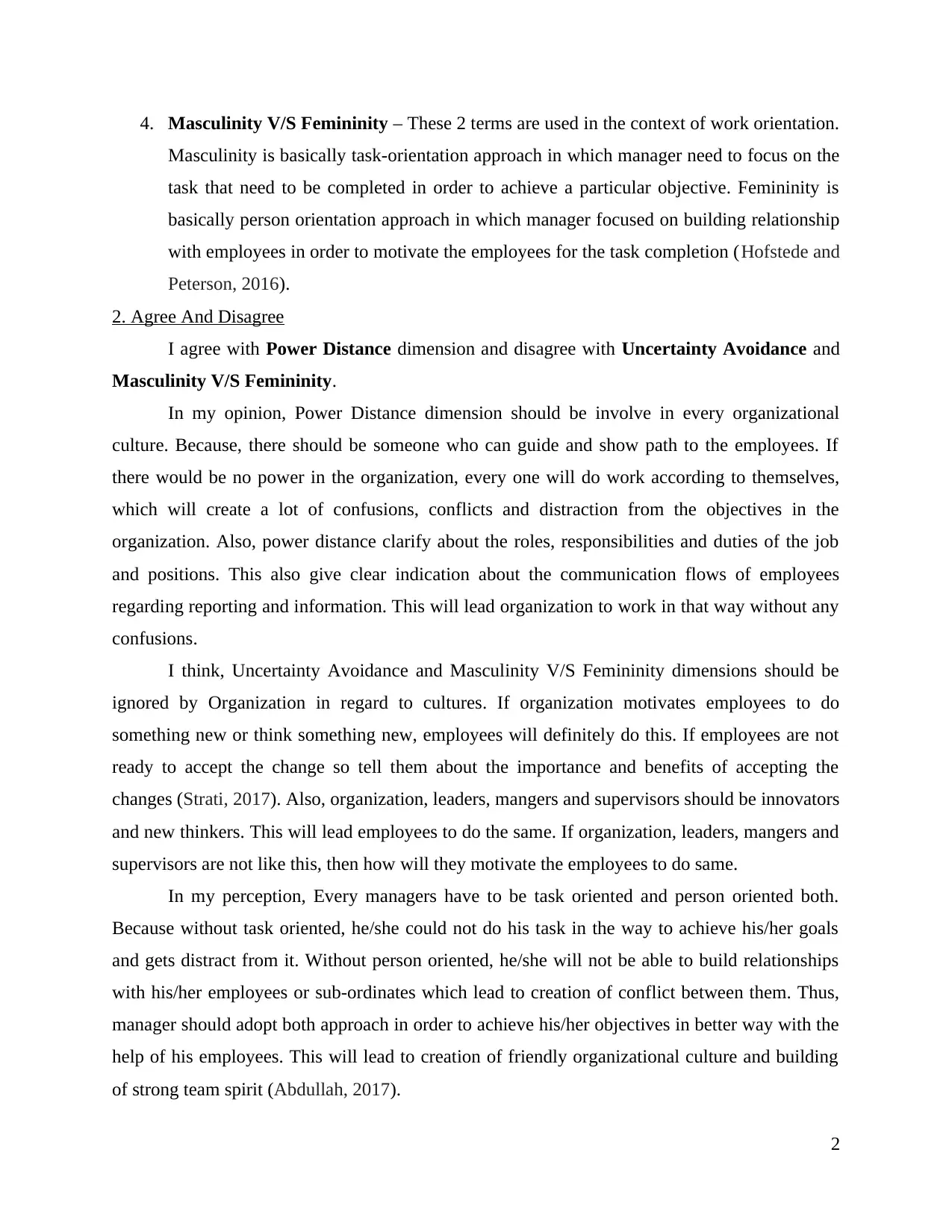
4. Masculinity V/S Femininity – These 2 terms are used in the context of work orientation.
Masculinity is basically task-orientation approach in which manager need to focus on the
task that need to be completed in order to achieve a particular objective. Femininity is
basically person orientation approach in which manager focused on building relationship
with employees in order to motivate the employees for the task completion (Hofstede and
Peterson, 2016).
2. Agree And Disagree
I agree with Power Distance dimension and disagree with Uncertainty Avoidance and
Masculinity V/S Femininity.
In my opinion, Power Distance dimension should be involve in every organizational
culture. Because, there should be someone who can guide and show path to the employees. If
there would be no power in the organization, every one will do work according to themselves,
which will create a lot of confusions, conflicts and distraction from the objectives in the
organization. Also, power distance clarify about the roles, responsibilities and duties of the job
and positions. This also give clear indication about the communication flows of employees
regarding reporting and information. This will lead organization to work in that way without any
confusions.
I think, Uncertainty Avoidance and Masculinity V/S Femininity dimensions should be
ignored by Organization in regard to cultures. If organization motivates employees to do
something new or think something new, employees will definitely do this. If employees are not
ready to accept the change so tell them about the importance and benefits of accepting the
changes (Strati, 2017). Also, organization, leaders, mangers and supervisors should be innovators
and new thinkers. This will lead employees to do the same. If organization, leaders, mangers and
supervisors are not like this, then how will they motivate the employees to do same.
In my perception, Every managers have to be task oriented and person oriented both.
Because without task oriented, he/she could not do his task in the way to achieve his/her goals
and gets distract from it. Without person oriented, he/she will not be able to build relationships
with his/her employees or sub-ordinates which lead to creation of conflict between them. Thus,
manager should adopt both approach in order to achieve his/her objectives in better way with the
help of his employees. This will lead to creation of friendly organizational culture and building
of strong team spirit (Abdullah, 2017).
2
Masculinity is basically task-orientation approach in which manager need to focus on the
task that need to be completed in order to achieve a particular objective. Femininity is
basically person orientation approach in which manager focused on building relationship
with employees in order to motivate the employees for the task completion (Hofstede and
Peterson, 2016).
2. Agree And Disagree
I agree with Power Distance dimension and disagree with Uncertainty Avoidance and
Masculinity V/S Femininity.
In my opinion, Power Distance dimension should be involve in every organizational
culture. Because, there should be someone who can guide and show path to the employees. If
there would be no power in the organization, every one will do work according to themselves,
which will create a lot of confusions, conflicts and distraction from the objectives in the
organization. Also, power distance clarify about the roles, responsibilities and duties of the job
and positions. This also give clear indication about the communication flows of employees
regarding reporting and information. This will lead organization to work in that way without any
confusions.
I think, Uncertainty Avoidance and Masculinity V/S Femininity dimensions should be
ignored by Organization in regard to cultures. If organization motivates employees to do
something new or think something new, employees will definitely do this. If employees are not
ready to accept the change so tell them about the importance and benefits of accepting the
changes (Strati, 2017). Also, organization, leaders, mangers and supervisors should be innovators
and new thinkers. This will lead employees to do the same. If organization, leaders, mangers and
supervisors are not like this, then how will they motivate the employees to do same.
In my perception, Every managers have to be task oriented and person oriented both.
Because without task oriented, he/she could not do his task in the way to achieve his/her goals
and gets distract from it. Without person oriented, he/she will not be able to build relationships
with his/her employees or sub-ordinates which lead to creation of conflict between them. Thus,
manager should adopt both approach in order to achieve his/her objectives in better way with the
help of his employees. This will lead to creation of friendly organizational culture and building
of strong team spirit (Abdullah, 2017).
2
Paraphrase This Document
Need a fresh take? Get an instant paraphrase of this document with our AI Paraphraser
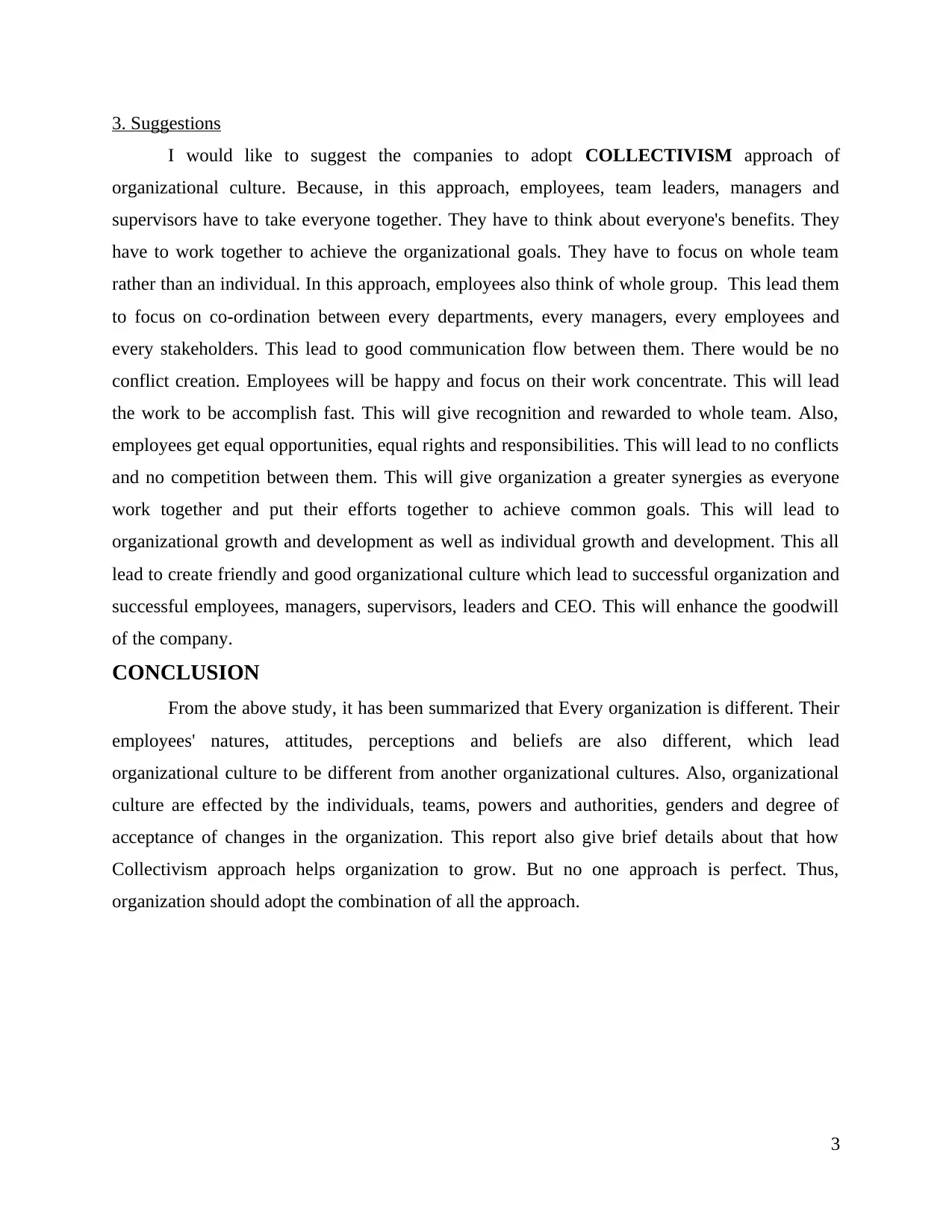
3. Suggestions
I would like to suggest the companies to adopt COLLECTIVISM approach of
organizational culture. Because, in this approach, employees, team leaders, managers and
supervisors have to take everyone together. They have to think about everyone's benefits. They
have to work together to achieve the organizational goals. They have to focus on whole team
rather than an individual. In this approach, employees also think of whole group. This lead them
to focus on co-ordination between every departments, every managers, every employees and
every stakeholders. This lead to good communication flow between them. There would be no
conflict creation. Employees will be happy and focus on their work concentrate. This will lead
the work to be accomplish fast. This will give recognition and rewarded to whole team. Also,
employees get equal opportunities, equal rights and responsibilities. This will lead to no conflicts
and no competition between them. This will give organization a greater synergies as everyone
work together and put their efforts together to achieve common goals. This will lead to
organizational growth and development as well as individual growth and development. This all
lead to create friendly and good organizational culture which lead to successful organization and
successful employees, managers, supervisors, leaders and CEO. This will enhance the goodwill
of the company.
CONCLUSION
From the above study, it has been summarized that Every organization is different. Their
employees' natures, attitudes, perceptions and beliefs are also different, which lead
organizational culture to be different from another organizational cultures. Also, organizational
culture are effected by the individuals, teams, powers and authorities, genders and degree of
acceptance of changes in the organization. This report also give brief details about that how
Collectivism approach helps organization to grow. But no one approach is perfect. Thus,
organization should adopt the combination of all the approach.
3
I would like to suggest the companies to adopt COLLECTIVISM approach of
organizational culture. Because, in this approach, employees, team leaders, managers and
supervisors have to take everyone together. They have to think about everyone's benefits. They
have to work together to achieve the organizational goals. They have to focus on whole team
rather than an individual. In this approach, employees also think of whole group. This lead them
to focus on co-ordination between every departments, every managers, every employees and
every stakeholders. This lead to good communication flow between them. There would be no
conflict creation. Employees will be happy and focus on their work concentrate. This will lead
the work to be accomplish fast. This will give recognition and rewarded to whole team. Also,
employees get equal opportunities, equal rights and responsibilities. This will lead to no conflicts
and no competition between them. This will give organization a greater synergies as everyone
work together and put their efforts together to achieve common goals. This will lead to
organizational growth and development as well as individual growth and development. This all
lead to create friendly and good organizational culture which lead to successful organization and
successful employees, managers, supervisors, leaders and CEO. This will enhance the goodwill
of the company.
CONCLUSION
From the above study, it has been summarized that Every organization is different. Their
employees' natures, attitudes, perceptions and beliefs are also different, which lead
organizational culture to be different from another organizational cultures. Also, organizational
culture are effected by the individuals, teams, powers and authorities, genders and degree of
acceptance of changes in the organization. This report also give brief details about that how
Collectivism approach helps organization to grow. But no one approach is perfect. Thus,
organization should adopt the combination of all the approach.
3
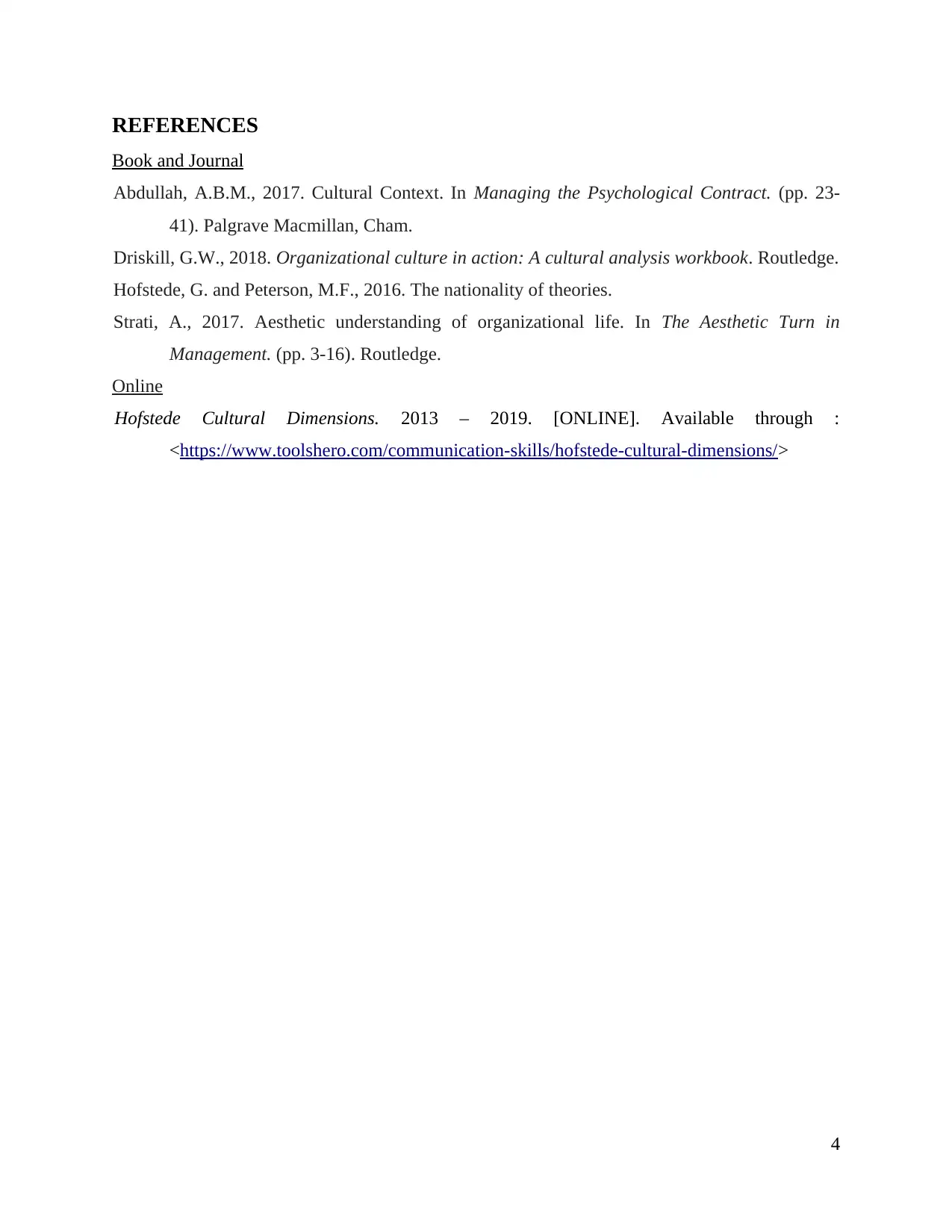
REFERENCES
Book and Journal
Abdullah, A.B.M., 2017. Cultural Context. In Managing the Psychological Contract. (pp. 23-
41). Palgrave Macmillan, Cham.
Driskill, G.W., 2018. Organizational culture in action: A cultural analysis workbook. Routledge.
Hofstede, G. and Peterson, M.F., 2016. The nationality of theories.
Strati, A., 2017. Aesthetic understanding of organizational life. In The Aesthetic Turn in
Management. (pp. 3-16). Routledge.
Online
Hofstede Cultural Dimensions. 2013 – 2019. [ONLINE]. Available through :
<https://www.toolshero.com/communication-skills/hofstede-cultural-dimensions/>
4
Book and Journal
Abdullah, A.B.M., 2017. Cultural Context. In Managing the Psychological Contract. (pp. 23-
41). Palgrave Macmillan, Cham.
Driskill, G.W., 2018. Organizational culture in action: A cultural analysis workbook. Routledge.
Hofstede, G. and Peterson, M.F., 2016. The nationality of theories.
Strati, A., 2017. Aesthetic understanding of organizational life. In The Aesthetic Turn in
Management. (pp. 3-16). Routledge.
Online
Hofstede Cultural Dimensions. 2013 – 2019. [ONLINE]. Available through :
<https://www.toolshero.com/communication-skills/hofstede-cultural-dimensions/>
4
⊘ This is a preview!⊘
Do you want full access?
Subscribe today to unlock all pages.

Trusted by 1+ million students worldwide
1 out of 6
Related Documents
Your All-in-One AI-Powered Toolkit for Academic Success.
+13062052269
info@desklib.com
Available 24*7 on WhatsApp / Email
![[object Object]](/_next/static/media/star-bottom.7253800d.svg)
Unlock your academic potential
Copyright © 2020–2025 A2Z Services. All Rights Reserved. Developed and managed by ZUCOL.





